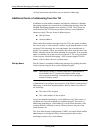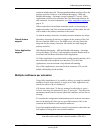
Avaya Modular Messaging Concepts and Planning Guide
6-14 November 2004
Avaya Modular Messaging Concepts and
Planning Guide
list, and the message is delivered to all of the ELA list
members.
Networking
The term ‘networking’ is used to describe how subscribers of a Modular
Messaging system can exchange messages with subscribers of other
Modular Messaging systems, or, in some cases, with users of other
voicemail systems.
Modular Messaging interoperates with other Modular Messaging systems
in the following manner:
! Modular Messaging—MSS. Provides native support to
SMTP/MIME networking, using which, subscribers can
exchange messages with:
— Subscribers of other Modular Messaging—MSS systems
— Subscribers of systems connected to an Avaya Message
Networking Server. The Message Networking Server
performs the conversion between SMTP/MIME and both
proprietary voicemail networking protocols (such as Octel
Analog, AUDIX TCP/IP, Aria TCP/IP, and Serenade TCP/IP)
and standard protocols (such as AMIS and VPIM).
Note: With Modular Messaging—MSS, networking is a
chargeable option, and facilitates networking
between a Modular Messaging—MSS system and a
Message Networking server. For simplified
administration, directory management, and
performance, customers are advised to consider
using a Message Networking server among multiple
Modular Messaging—Avaya MSS systems. For
more information, see Modular Messaging—MSS
and the Message Networking Server on page 6-15.
! Using native networking, Modular Messaging—Exchange
subscribers can exchange messages with subscribers of other
Modular Messaging—Exchange systems and Modular
Messaging—IBM Lotus Domino subscribers can exchange
messages with subscribers of other Modular Messaging—IBM
Lotus Domino systems
! Modular Messaging—Microsoft Exchange and Modular
Messaging—IBM Lotus Domino systems also interoperate with
systems connected to an Avaya Message Networking Server.
However, networking between heterogeneous systems requires


















